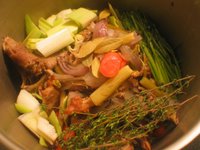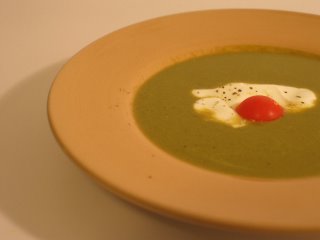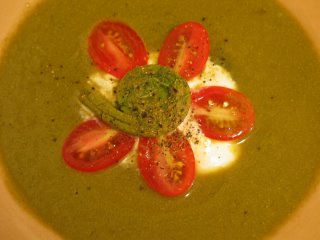The ingredients for this edition of Paper Chef as found on
Tomatilla and
An Electronic Restaurant are:
- Rice (good, I have a few bags of different types of rice on my shelves)
- Carrots (cheap, good and readily available = perfect!)
- Anchovies (salty, pungent… excellent to kick up almost any recipe… great!)
- Something from the other side of the world that helps make this dish a celebration for you. (Celebration… ok… Food is festive… but where the heck is the opposite of the world?)
I feel quite at ease with most ingredients this week, but I didn’t realize there would be some geographical research involved in this. I dropped out of my PhD studies in geography a few months ago and now I have to get back at it? Procrastinating my way to an answer using internet I found this
website which can help any of you to know where that other end of the world is located.
I live in Ottawa, Canada. The opposite of the world, for me, is in the South Indian Ocean just between Australia (hello, dear judges) and the Kerguelen Islands, a remnant of the French Empire. The only commercially available product coming out of these waters found in my area, at least the only one that I am aware of, is the
Chilean Sea Bass which is found in the cold seas surrounding Antarctica. It used to be abundant but has been over-fished for the years now and many fear its future might resemble the fate of the
Atlantic cod, a social and ecological disaster well known here in Canada. There are already
many people involved in the politics of fishing over this species. As such, I am a bit reluctant to use the product.
There are also some problems in dealing with the antipode approach to this “other-side-of-the-world” theme. After all, antipodes, by their physical nature, are usually quite similar, at least ecologically speaking: the climate is usually similar and so is the agriculture practised in each places. There are, of course, cultural differences that usually come into play when such distances are involved. In my case, however, the colonial powers of the last centuries pretty much erased many of the cultural differences between here and the antipode. Ottawa, the city where I now reside is a French and English bilingual city, the capital of a country made of a cultural compromises between these two same European traditions along with a few trace from a long repressed native culture. The antipode of Ottawa, as you know by now, is located between Australia, a country which resemble Canada in many ways obviously without the French influences, and the Kerguelen Islands, a French territory in the Indian Ocean. We are therefore talking about an essentially western culture combining both English and French influences at each point of the antipode.
Perhaps this “other side of the world” theme is more evocative in nature and one could imagine many ways to look at the problem. For instance, we could do like
2-minute Noodle Cook did and use the equator to make a reflection around the waistline of our planet. One could also count 12 time zones to find the opposite slice of the planet or get the equivalent of a place’s latitude in the opposite hemisphere. I bet one could even create a complicated equation which would factor a certain degree of randomness, especially along the latitude gradient, to find a place as different as possible from one’s own.
As for myself, I’ve arbitrarily decided to go the easy way and pretend that China is the opposite of where I live. Since my girlfriend is Chinese, it makes this decision a bit suspicious, so let me explain such a choice. Firstly, there are exactly 12 hours between here and China and therefore it is on the opposite side of the planet in terms of day and nights. Secondly, although the climate is extremely diverse in China from North to South and even East to West, most of the places I visited there are in very hot subtropical areas that are at the climatic opposite of my dear cold Canada. Thirdly, China is very different, culturally speaking, from the western world (at least this is what I slowly start to understand after more than 4 years of common life with my wonderful partner). Fourthly, China is where cartoons characters tend to end up when they dig a hole through the Earth. Finally, it was cold and snowy today and I didn’t want to browse from shop to shop for a product that I was not even sure to find. So I went through my girlfriend’s spice rack, picked a few bottles and smelled them to find the perfect ingredient: some kind of mixed spices that I thought would complement the dish I had in mind.
You will know about this dish in a few minutes, but let’s recapitulate for now. The ingredients that had to be part of my dish would then be
- Carrots
- Anchovies
- Rice
- A Chinese spice mix (I can’t be more specific for the moment since I just can’t read the label but I am guessing there is a good amount of star anis in there)
Now, one of the suggested paths was to make something celebratory. At home, we try to make every meal as festive as we can. Life is too short for boredom, so even the simplest hot dog meal has to be as festive as possible.
On the other hand, there are some traditions around festivities in my family. One of my favourite is the Sunday brunch at my mom’s place. We usually end up eating soft-boiled eggs, croissants, cheese, some charcuteries and a ton of fruits. It is the soft boiled egg avenue that I decided to follow for this edition of paper chef.
Now you have waited long enough, here it is: the “
carrot and anchovies rice-croquette fake soft boiled egg” with a slight Chinese spices accent and made of recycled products at 70%. I had the idea of making such a dish while thinking about rice croquettes, Japanese breakfast rice balls with a piece of fish hidden inside and, of course, soft boiled eggs.

Two days ago, I made a risotto and we had some leftover in the fridge. Risotto is rarely good when reheated so I had to find an imaginative way
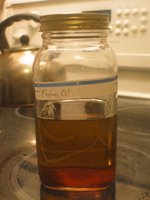
to use it and avoid loosing it. This edition of Paper Chef came to the rescue forcing me to deal with a great list of ingredients that got my mind going: carrots, rice and anchovies. Since I noticed that a ‘Super Saver’ category had been created, my desire to use my old risotto grew even stronger and I made an extra effort to keep everything as cheap as possible. As such, I decide to use the oil in which my anchovies are kept instead of the anchovies themselves and to stick to a minimal amount of ingredients. Heck! I even recycled my old frying oil for this recipe.
Here’s the recipe:
Carrot and anchovies rice-croquette or fake soft boiled eggIngredients:
- Old risotto (one with few added ingredients)
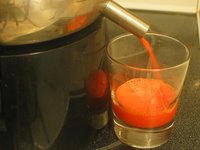 About 1 cup of carrot juice
About 1 cup of carrot juice
- About I teaspoon of ‘anchovy oil’ (the oil from your jar of oil packed anchovies)
- The same amount of flour
- 1 small pack of gelatine
- A good pinch of that Chinese spice mix on my girlfriend’s spice rack
- Sea salt (remember, the antipode of where I live is the Ocean)
- Frying oil
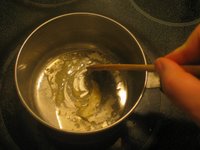
Steps:
- In a small bowl, mix the gelatine with half of the carrot juice.
- In a sauce pan, make a roux using the flour and the anchovy oil.
- Slowly add the other half of
 the carrot juice and the spices.
the carrot juice and the spices.
- When the sauce has thickened and almost reaches boiling point, pour it in the small bowl with the rest of the juice and gelatine. Mix well. Verify seasoning and add salt if needed.
- Place in the fridge for a few hours to set.
- Once set, use a melon baler or a spoon to mould your ‘egg yolks’

- Using the old risotto, mould eggs and place one of your carrot and anchovies ‘egg yolk’ in each of them.
- Deep fry each egg for a few minutes until they are golden brown.
The result is a nice crunchy rice croquette with its own sauce
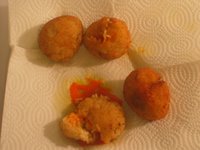
inside. The gelatine, by making the sauce solid at cold temperature, helps when creating the desired shape but melts during the cooking process giving the impression of a decadent runny yolk of a soft boiled egg. We served them with a bit of coriander leaves because we thought that deep-frying stuff would mean a somewhat greasy food but we were probably able to control the temperature enough to avoid that unpleasant greasiness. Oh, yeah… this must be awesome with a
cold beer (do I get a bonus point for mentioning beer here?).
Now we are asked to nominate ourselves for one of the four categories. Let’s see where I could fit:
Paper Chef Personality - creative, clever or witty writer (English is a second language to me and I don’t feel like a very clever or witty writer…….. yet)
Paper Chef Super Saver - budget meals or crowd pleaser specialist (Hey… I used recycled ingredients like ‘anchovy oil’ and an old risotto… my carrots were in a 10 pounds bag that I only paid 1$... and to top that I also used recycled oil to fry my ‘eggs’… I could be a winner here)
Paper Chef Prestige - food styling, presentation or plating up expert (not my specialty… I’m actually quite bad at this)
Paper Chef Nutrition Genie - magician for getting fussy diners to eat veggies, less salt, less fat (hum, my dish is probably a bit too fat to fit in there… but I’m sure kids would love to eat carrots this way)
Paper Chef Supreme - the champion for Paper Chef #13 (I’d love to win this one but there are some awesome cooks out there… I’ll pass)
So I officially nominate myself in the
Super Saver category!
And as for the gifts… In the event that I win one, I’d like to get the
Ground Australian bush spice sampler pack. I’d love to try to other ingredients too but a sampler pack seems like a good option in order to satisfy my curiosity. I’m just afraid I’ll get addicted to some of those and have to rely on mail order in the very near future.

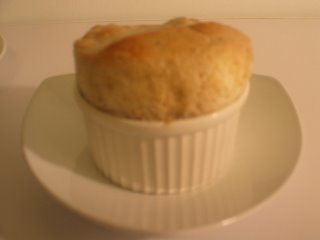





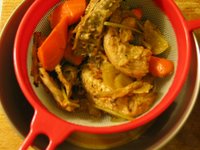










 .
.


